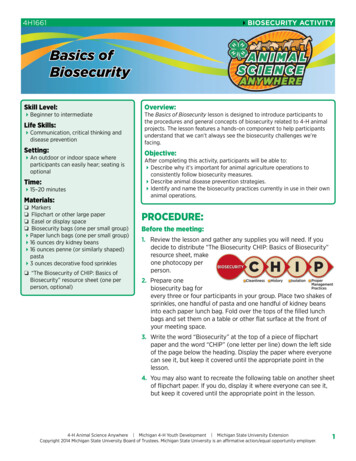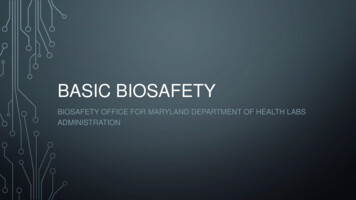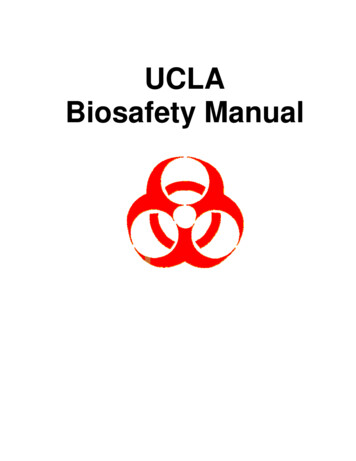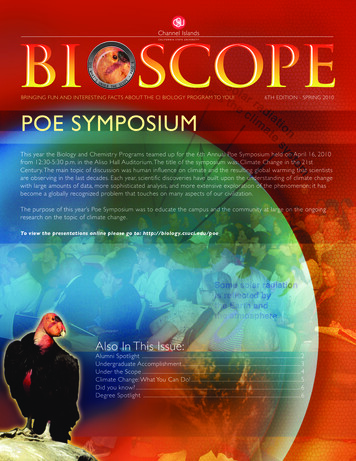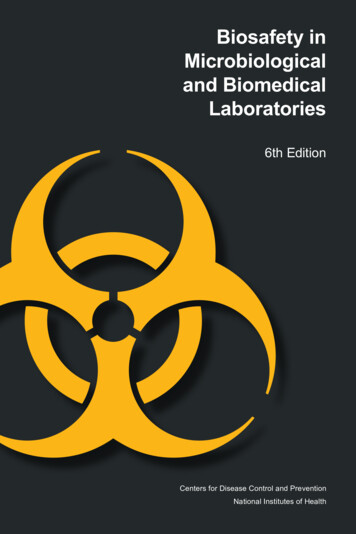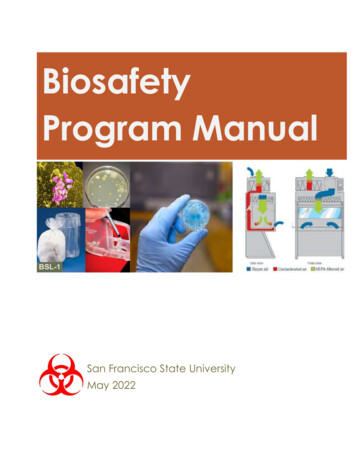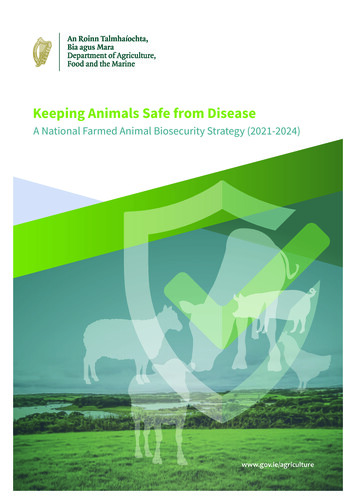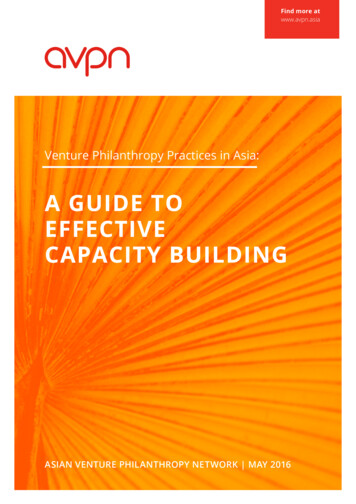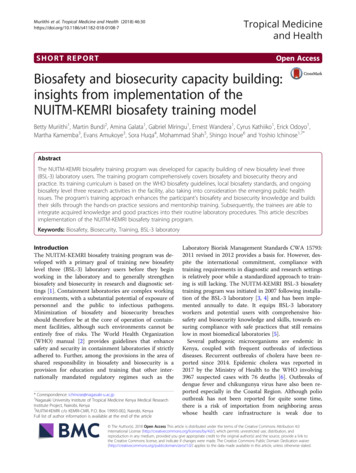
Transcription
Muriithi et al. Tropical Medicine and Health (2018) T REPORTTropical Medicineand HealthOpen AccessBiosafety and biosecurity capacity building:insights from implementation of theNUITM-KEMRI biosafety training modelBetty Muriithi1, Martin Bundi2, Amina Galata1, Gabriel Miringu1, Ernest Wandera1, Cyrus Kathiiko1, Erick Odoyo1,Martha Kamemba3, Evans Amukoye3, Sora Huqa4, Mohammad Shah5, Shingo Inoue6 and Yoshio Ichinose1,7*AbstractThe NUITM-KEMRI biosafety training program was developed for capacity building of new biosafety level three(BSL-3) laboratory users. The training program comprehensively covers biosafety and biosecurity theory andpractice. Its training curriculum is based on the WHO biosafety guidelines, local biosafety standards, and ongoingbiosafety level three research activities in the facility, also taking into consideration the emerging public healthissues. The program’s training approach enhances the participant’s biosafety and biosecurity knowledge and buildstheir skills through the hands-on practice sessions and mentorship training. Subsequently, the trainees are able tointegrate acquired knowledge and good practices into their routine laboratory procedures. This article describesimplementation of the NUITM-KEMRI biosafety training program.Keywords: Biosafety, Biosecurity, Training, BSL-3 laboratoryIntroductionThe NUITM-KEMRI biosafety training program was developed with a primary goal of training new biosafetylevel three (BSL-3) laboratory users before they beginworking in the laboratory and to generally strengthenbiosafety and biosecurity in research and diagnostic settings [1]. Containment laboratories are complex workingenvironments, with a substantial potential of exposure ofpersonnel and the public to infectious pathogens.Minimization of biosafety and biosecurity breachesshould therefore be at the core of operation of containment facilities, although such environments cannot beentirely free of risks. The World Health Organization(WHO) manual [2] provides guidelines that enhancesafety and security in containment laboratories if strictlyadhered to. Further, among the provisions in the area ofshared responsibility in biosafety and biosecurity is aprovision for education and training that other internationally mandated regulatory regimes such as the* Correspondence: ichinose@nagasaki-u.ac.jp1Nagasaki University Institute of Tropical Medicine Kenya Medical ResearchInstitute Project, Nairobi, Kenya7NUITM-KEMRI c/o KEMRI-CMR, P.O. Box 19993-002, Nairobi, KenyaFull list of author information is available at the end of the articleLaboratory Biorisk Management Standards CWA 15793:2011 revised in 2012 provides a basis for. However, despite the international commitment, compliance withtraining requirements in diagnostic and research settingsis relatively poor while a standardized approach to training is still lacking. The NUITM-KEMRI BSL-3 biosafetytraining program was initiated in 2007 following installation of the BSL-3 laboratory [3, 4] and has been implemented annually to date. It equips BSL-3 laboratoryworkers and potential users with comprehensive biosafety and biosecurity knowledge and skills, towards ensuring compliance with safe practices that still remainslow in most biomedical laboratories [5].Several pathogenic microorganisms are endemic inKenya, coupled with frequent outbreaks of infectiousdiseases. Recurrent outbreaks of cholera have been reported since 2014. Epidemic cholera was reported in2017 by the Ministry of Health to the WHO involving3967 suspected cases with 76 deaths [6]. Outbreaks ofdengue fever and chikungunya virus have also been reported especially in the Coastal Region. Although poliooutbreak has not been reported for quite some time,there is a risk of importation from neighboring areaswhose health care infrastructure is weak due to The Author(s). 2018 Open Access This article is distributed under the terms of the Creative Commons Attribution 4.0International License (http://creativecommons.org/licenses/by/4.0/), which permits unrestricted use, distribution, andreproduction in any medium, provided you give appropriate credit to the original author(s) and the source, provide a link tothe Creative Commons license, and indicate if changes were made. The Creative Commons Public Domain Dedication o/1.0/) applies to the data made available in this article, unless otherwise stated.
Muriithi et al. Tropical Medicine and Health (2018) 46:30socio-political instability. Yellow fever and Rift Valleyfever still pose a public health threat due to prevalenceof competent vectors among other factors. Given thehuge burden of infectious diseases, the potential of encountering unexpected infectious agents in routine samples is high. The frequent occurrence of these diseasescaused by risk group two and three agents and their associated morbidity and mortality therefore justifies theneed for capacity building of laboratory staff, particularlythose working in BSL-3 laboratories and laboratorieswith enhancements over and above statutory level twostandards. As Ritterson and Cassagrande [7] noted, human error is an important cause of laboratory accidents.Moreover, laboratory-acquired infections are still rampant despite firmly established good microbiologicaltechniques in most laboratories.Globally, the WHO laboratory biosafety guidelines, theCEN Workshop Agreement (CWA) 15793 LaboratoryBiorisk Management International consensus document,and the Biological Weapons Convention (BWC) amongother international instruments guide biosafety and biosecurity management. The CWA 15793 is intended tobe used as a framework to implement national guidelines and policies related to biosafety and biosecurity.Locally, the Kenya biosafety policy guidelines in additionto the Occupational Safety and Health Act (OSHA) 2007regulation, Environmental Management and Coordination (Amendment) Act 2015, and National InfectionPrevention and Control Guidelines for health care services in Kenya offer guidelines in biosafety and biosecurity management in the country. These guidelinesprovide a basis for biosafety and biosecurity training.BSL-3 biosafety training is mostly provided by researchinstitutions, universities, and or regional biosafety associations, networks, or agencies [8, 9]. Training curriculum isdeveloped based on the training needs of the target groupamong other determinants. Homer et al. [10] for instanceproposes ten key training concepts for workers assignedto BSL-3 laboratories that cover a broad range of core biosafety and biosecurity concepts. On the contrary, Hartman, et al. [8] describes a facility-specific training programwhose content covers operation of an institution’s BSL-3laboratory, an approach also used by most universities thatprovide BSL-3 biosafety training. The WHO manual [2]and other internationally recognized documents are alsoused to develop training curriculums depending on institutional needs and settings [11]. Despite the need to integrate BSL-3 laboratory training with BSL-3 laboratoryoperations, availability of resources and human capacity,as well as lack of legal framework upon which trainingguidelines can be established, remain to be important impediments [12].The NUITM-KEMRI biosafety training program wasdeveloped based on the WHO laboratory biosafetyPage 2 of 7manual (2004), with input from ongoing research studiesas well as the prevailing public health conditions. Training objectives were designed around the knowledge andskills that the trainees are expected to demonstrate afterthe training, while factoring in the latter conditions. Training content was therefore developed in consultation withexperienced BSL-3 laboratory personnel, biosafety officers,and relevant scientists.Training procedureTraining contentThe training content is largely based on the WHO Laboratory Biosafety Manual [2]. The manual primarily addresses laboratory biosafety, providing guidelines forestablishment of containment principles, and practicesthat prevent unintentional exposure to biological agentsand toxins.Table 1 below outlines the training program. An initialwritten quiz or survey is first administered. The quizcovers all the contents taught during the training whilethe survey is based on a single predetermined topic. Initial assessment is used to gauge the trainees’ baselineknowledge and awareness of biosafety and biosecurityprinciples. In the next phase, trainees are subjected totheoretical and practical training. Theoretical trainingcovers concept and knowledge, the NUITM P3 laboratory, and operations inside the BSL-3 laboratory categories. The concept and knowledge category introducestrainees to the concept of biosafety and biosecurity. Arationale for biosafety and biosecurity is providedthrough a detailed description of laboratory-acquired infections through which the impact of breaching biosafetyand biosecurity principles is discussed. Also covered underthis category is risk group classification of microorganismsand biosafety classification of laboratories alongside riskassessment. These modules enable trainees to allocate necessary safety strategies to individual microorganismsbased on potential risk borne. Biosafety containment ateach biosafety level is discussed too including biosafetyequipment, biosafety rules, regulations, and waste management at each level. Additionally, trainees learn basicmycology, virology, and bacteriology through applicationmodules that provide practical examples on handling ofselect pathogens.In the second category, the NUITM BSL-3 laboratorysystem is described. The physical and operationalfeatures of the laboratory and the role each plays inmaintaining containment is first described. Biosafetyequipment including personal protective equipment(PPE) are reviewed too, alongside routine care and maintenance of the facility. The last category covers the theory of operation of the BSL-3 laboratory, from entry intothe laboratory to exit following completion of an experimental procedure. Entry usually starts with routine
Muriithi et al. Tropical Medicine and Health (2018) 46:30Page 3 of 7Table 1 Training program outlineTraining phaseDescriptionMethodInitial assessmentPre-training quizPre-training surveySit-in examinationTraining phaseTheory Concept and knowledgeBackground of laboratory-acquired infectionsMicroorganisms risk group classificationBiosafety containment levelsBiosafety containment strategies; facilities and techniquesSample packaging and transportationBasic mycology, virology and bacteriologyBiological and chemical waste managementBiosecurity NUITM BSL-3 laboratory: features, maintenance and managementLaboratory designPhysical and operational features of the NUITM P3 labBiosafety equipmentRoutine care and maintenance Operations inside the BSL-3 laboratoryLaboratory entry checkpointsDocumentationDecontaminationAppropriate use of personal protective equipmentProtocols and procedures for working in the BSL-3 laboratoryExit procedures and troublePracticumSite visit to the checkpointsDemonstration of the correct procedure of entering, working insidethe facility and exiting the BSL-3 laboratoryHands-on evaluation session Final assessmentPre-training quizPre-training surveymonitoring of checkpoints. Each checkpoint and required documentation is therefore described followed byprotocols and procedures for working in the BSL-3 laboratory. Among the checkpoints are the cell cultureroom where availability of the BSL-3 suit is confirmed,the machine room for recording of manometer reading,and the ante room where BSL-3 suit operational parameters are observed and recorded. BSL-3 laboratoryequipment including safety equipment are then described in detail as well as their operation, followed by adescription of the systematic exit procedures.The practical session is conducted based on the content covered in the second category. Demonstration andpractice on donning and doffing of PPE is conductedfollowed by hands-on training on entering, working andleaving the BSL-3 laboratory. During this session,trainees are shown how to use the biosafety cabinets, autoclaves, and centrifuges. Sample handling is also covered, including retrieval, experimentation, disposal,storage, and inventory. The training phase is followed bythe final assessment phase during when a written assessment similar the initial assessment is administered.Whenever applicable, a final topical survey is also administered. These are used to measure knowledge gainedduring the workshop.LecturesDiscussionDemonstration by trainersDemonstration by traineesHands-on practice by traineesTraining deliveryThe training program is administered through an annual3-day workshop. Theoretical training is conducted during the first day and part of the second day. Practicaltraining begins after theoretical training on the secondday and on the third day. Training evaluation followspractical training towards the end of the workshop. Adiscussion session is finally held, during which the written evaluations are discussed and questions arising fromall sessions of the workshop responded to.The training program is delivered through lectures,demonstrations, and hands-on training [1, 14]. Lecturesare used to deliver theoretical content while demonstrations and hands-on training are used to administer thepractical content.Training participants and trainersTrainees are drawn from research centers and related research institutions. They are usually laboratory staff withexperience in lower biosafety level laboratories, staff withaccess to the BSL-3 laboratory, or potential BSL-3 laboratory users. Trainees are mostly virologists and bacteriologists. Prerequisite requirement for inclusion in theworkshop is knowledge and experience in basic microbiology practices. At least 12 trainees are recruited every year.
Muriithi et al. Tropical Medicine and Health (2018) 46:30Trainers are sourced internally and externally.Trainers of introductory and practical modules are usually previously trained BSL-3 laboratory staff with atleast 3 years of experience in BSL-3 settings, frequentusers of the BSL-3 laboratory, with an academic background of medical laboratory sciences. Application modules are administered by research officers. These aremajorly investigators conducting studies on an organismof biosafety interest. They must be familiar with goodmicrobiology practices. Biosafety and biosecurity professionals are engaged where applicable.Page 4 of 7Refresher and mentorship and trainingFeedback on training is obtained to examine the level ofsatisfaction of the trainees. Structured questionnaires designed to collect trainees’ opinions on training content,quality of the training materials, suitability of trainingapproaches, and overall impression of the entire workshop are used. Questionnaires are anonymous and consist of yes and no, and open ended questions, for eachmodule and the overall training workshop.Resulting information is used for continuous improvement of the training program. For instance, feedback onthe duration of training yields opinions on the adequacyof the allocated time while questions addressing trainingcontent yield feedback on curriculum coverage and thesuitability of the training materials used.Mentorship training is conducted following successfulcompletion of classroom and practical sessions. It is alsoadministered to previously trained laboratory staff upona change in the scope of their work.During mentorship training, the mentor works whilethe trainee observes or vice versa, depending on theprior experience of the trainee and complexity of the experiments being undertaken. An ideal mentor is usuallya highly experienced BSL-3 laboratory staff who has hadprevious training and works in the laboratory on a regular basis. Mentorship allows trainees to practically applyknowledge and skills gained through the training and facilitates the development of expertise in a setting withincreasingly minimized potential risks. Duration of mentored training depends on how fast a trainee demonstrates capability of working independently and theextent of his/her prior experience. Mentored training ismonitored using a checklist that details core safety practices that must be learned.Finally, refresher training is incorporated in the training program to sustain skills and for continuous learning. Previously trained users participate in all sessions ofthe training workshop apart from evaluations. Refreshertraining is also conducted when a new study is about tobe started in order to update users on new standard operating procedures or safety strategies.Training evaluationMonthly biosafety meetingsTraining is evaluated using written evaluations. Thepost-training test is issued after the training while thehands-on training test is administered after the hands-ontraining session. A total of 38 multiple-choice questionsare administered. Whenever applicable, topical pre- andpost-training surveys are conducted, or a pre-training testsimilar to the post-training test administered.Pre-training scores are normally lower than post-trainingscores. A significant improvement is however observed inthe post-training evaluation in most cases. Medina et al.[15] reported a statistically significant increase in the meanscore by 30% after training. Johnson et al. [16] also reportedthat post-training scores increased by over 30% in somedisciplines after training. Similarly, Inoue et al. [13] andMiring’u et al. [14] reported higher post-training scoreswhile evaluating the NUITM-KEMRI biosafety trainingprogram and surveying knowledge and practices in the useof biosafety cabinets, respectively. Addo et al. [17] furtherobserved that, in addition to increasing post-training scores,training also increased personnel motivation resulting inthe strengthening of tuberculosis laboratory services inGhana. The increase in scores usually suggests the extentof learning achieved. Modules can however be performeddifferently based on level of complexity and experience profiles of the trainees.Biosafety meetings are convened once per month for alltrained BSL-3 laboratory staff. Accidents, incidents, orlessons learned are discussed, as well as ongoing activities, challenges being experienced while working in thelaboratory, and other upcoming issues. Changes made tothe operation protocols of each team are describedwhere applicable. The biosafety officer further reportsmechanical or operational faults if any, with safety precautions and course of action that the users can take incase of occurrence during a work session. Informationsharing undertaken during such meetings provide amulti sectoral approach to training and awareness raising required by the interdisciplinary nature of lifesciences.Training feedbackDiscussionThe training program is currently in its tenth year of implementation. One hundred fifteen laboratory staff havebeen trained so far as shown in Fig. 1 below.A minimum number of trainees is enrolled each year.The small number allows for closer instruction especiallyduring the hands-on training. Initially, trainees were predominantly junior researchers. The catchment has sinceexpanded to include laboratory workers of diagnosticand reference laboratories. Observing that most of the
Muriithi et al. Tropical Medicine and Health (2018) 46:30Fig. 1 Number of trainees per annual biosafety training workshoptrainees work in biosafety level two laboratories or enhanced level two laboratories, successful trainees whoneed to begin work in the BSL-3 laboratory are immediately enrolled in the mentorship program. Despite thelimited number of active BSL-3 laboratories in the country, the demand for biosafety and biosecurity training isrising as more laboratories seek to standardize their operations towards quality accreditation alongside risingpressure for worker and public protection.Figure 2 shows annual average scores since inceptionof the training program, computed from post-trainingwritten evaluations. The pass mark is usually 70%. Despite the absence of a clear trend, majority of the workshop scores have been above average. Further,modification of the program has been ongoing everyyear that has impacted the scores in one way or another.At inception, the biosafety training curriculum consistedof nine modules that majorly focused on functional andoperational aspects of the BSL-3 laboratory and less onbiosafety and biosecurity basic concepts and knowledge.Training content in this initial workshop was objectivelyfocused on instilling skills and knowledge needed towork in a BSL-3 laboratory. The trainees were laboratorystaff who were preparing to work in the BSL-3 laboratory, some of whom had access to the BSL-3 laboratory.Initial workshops also served the purpose of training oftrainers, who would later be engaged in administeringpractical modules of the program.Fig. 2 Trainee average scores in the annual biosafety level 3training workshopsPage 5 of 7In 2009, a review of the workshop’s outcomes in the first2 years indicated the need to diversify training content inorder to meet theoretical basic biosafety training needs.Training content was therefore revised to give more emphasis on core biosafety and biosecurity principles. Introductory modules were subsequently expanded to providedetails on concepts such as the biocontainment principles,risk assessment of microorganisms, BSL-3 biosafety regulations, disinfection, and decontamination among others.Additional application modules were introduced to exemplify practical application of learned concepts for particular organisms. Further, the number of trainees perworkshop was reduced to 12 to facilitate one-on-one practical training. The trainers provided questions for the written evaluation unlike in previous years whereby theorganizers drafted the questions.Further modification conducted prior to the 2010workshop streamlined BSL-3 laboratory theoretical andpractical training. Two introductory modules were replaced with application modules. A module on biosafetycabinets was added owing to the role they play in containing infectious agents coupled with the importance ofcorrect usage for optimal containment. For sequentialcoverage of the concept of biocontainment, trainingcontent covering design and structural features of theBSL-3 was separated from the introductory module andmerged with the maintenance of the BSL-3 laboratorymodule. To simplify practical training, a hands-on training checklist was extracted from the hands-on trainingtheoretical module on practices in the BSL-3 laboratory.The structured checklist consists of a stepwise systematic procedure for working in the BSL-3 laboratory, starting with entry preparations done in the cellculture room to setting up and completing an experiment, and finally exit procedures. Further, traineefeedback forms were introduced to collect feedbackfrom trainees on various aspects of the workshop forcontinuous improvement of the program. Previouslytrained biosafety staff were involved in deliveringsome of the lectures as well as in practical and discussion sessions.Feedback from 2010 trainees indicated that the training content was too wide. In 2011, the curriculum wastherefore reduced to 11 modules. Theoretical module onhow to use the BSL-3 laboratory was combined with itspractical session. Additionally, the BSL-3 laboratory bythen had permanent staff who had completed mentorship training. Their participation in the hands-on training sessions positively influenced training outcomes dueto increased contact between the trainers and thetrainees. In 2012, a demonstration session on donningand doffing of PPE was added. Addition of this sessionhelped to emphasize the role PPE plays in minimizingcontact with biological materials as well as providing a
Muriithi et al. Tropical Medicine and Health (2018) 46:30rationale for correct donning and doffing of PPE at allbiosafety levels. Additionally, the introductory modulecovering biosafety regulations was also revised to includebiological and chemical waste management. Such wastesbear biological and chemical hazards respectively; hence,optimal caution in their handling is required.In 2015, the workshop duration was extended to3 days. The late morning and entire afternoon of thesecond day have since been allocated to practical training. The hands-on training is conducted through threeor four groups, each with one or two trainers. Hands-onactivity includes routine procedure for entry into theBSL-3 lab, specimen and equipment handling, and the exitprocedure. Twelve modules were administered, includingan additional application module covering level three bacterial agents. During the same year, a practical quiz wasalso included as part of the assessment to measure learning achieved during practical training. The quiz is administered immediately after the hands-on session.As at 2017, need for training on practical execution ofBSL-3 laboratory key routines emerged. Waste management, being a common routine was expanded to coverbiological waste management and chemical waste management separately, since each type of waste bears different biosafety implications. Given the growing need fortransportation of biological materials, necessitated by increasing popularity of multi-site studies, a module covering shipment of biological materials was added. Itscontent was based on international standards for packaging and shipment of biological materials. Biosafetylevel three bacterial agents application module, whichpreviously covered biosafety and biosecurity of Bacillusanthracis, was also expanded to include a range of riskgroup three microorganisms with focus on pathogensthat cause septicemia. To further improve basic biosafetyand biosecurity awareness coupled with the importanceof biosafety level two laboratories in Kenya, a module onworking safely in BSL-2 laboratories was also includedin the curriculum. Lastly, a module on biosecurity wasadded. This module describes biosecurity in the international context, stakeholders in biosecurity issues, biosecurity regulations in Kenya, ongoing biosecurityinitiatives, and measures of improving biosecurity in research and diagnostic laboratories.Currently, the curriculum consists of 13 modules including an introductory module, three modules on biosafety operations and regulations, three applicationmodules, a module on biosafety in level two laboratories,four modules on BSL-3 laboratory, and a biosecuritymodule. Although the curriculum has not digressedfrom its initial objective, it has undergone severalchanges to effectively cover critical aspects of biosafetyand biosecurity in the BSL-3 laboratory. An evaluationof the training program by Inoue et al. [13] indicatedPage 6 of 7that it was able to significantly increase biosafety andbiosecurity awareness post-training, with accompanyingmentorship training and institutional support. The importance of practical training has also been acknowledged in the course of implementation of the program.Practical training through hands-on practice is widelyrecognized as means of instilling good biosafety and biosecurity practices among containment laboratories staffsince it influences behavioral change that spills over toroutine practices [18]. Practical training has thereforebeen extensively integrated into the training program,with almost half of the training duration dedicated forhands-on training. Trainee feedback on practical traininghas been positive all through.ConclusionImplementation of the NUITM-KEMRI biosafety training program has been quite successful as confirmed byabove average scores in the post-training evaluations aswell as positive trainee feedback. Further, the trainingcurriculum has been flexible enough to continuously accommodate emerging training needs, which has resultedto significant continuous improvement of the trainingprogram. A biosafety training program is therefore acritical tool in entrenching good biosafety and biosecurity in laboratory practices. Although many institutionshave developed and administers laboratory biosafetytraining programs, peer-reviewed training programs arelargely lacking. Many programs are implemented internally and maintained as internal institutional guidelineswith minimal presence in peer-reviewed journals. Despitethe differences in training content due to differing trainingneeds and differences in settings, standardization of biosafety training as well as provision of reference for development or improvement of biosafety training programs isdesirable.AbbreviationsBSL: Biosafety level; KEMRI: Kenya Medical Research Institute;NUITM: Nagasaki University Institute of Tropical Medicine; PPE: PersonalProtective Equipment; WHO: World Health OrganizationAcknowledgementsWe thank the Director of KEMRI for supporting the activities of our project.We also thank all our trainers for facilitating the annual workshops.FundingThe preparation of this manuscript was supported by Japan Society forPromotion of Sciences (JSPS) grant in aid for scientific research; grantnumber 15H05286.Availability of data and materialsOnly summary data was used in the manuscript. The training content can beviewed from [1, 14]. There were no other materials applied or obtainedtowards development of the manuscript.Authors’ contributionsBM, GM, MB, and EW developed the topic and drafted the manuscript. BM,MB, AG, GM, and EW revised the manuscript and prepared the resubmissiondocuments. AG, CK, and EO provided administrative support and helped in
Muriithi et al. Tropical Medicine and Health (2018) 46:30reviewing the manuscript at all stages. MK, EA, SH, MS, and SI developed asummary of the training procedure. MS and SI also participated in the reviewof the content of the manuscript. YI developed the topic and providedtechnical support. All authors read and approved the manuscript forpublication.
The NUITM-KEMRI biosafety training program was developed for capacity building of new biosafety level three (BSL-3) laboratory users. The training program comprehensively covers biosafety and biosecurity theory and practice. Its training curriculum is based on the WHO biosafety guidelines, local biosafety standards, and ongoing

